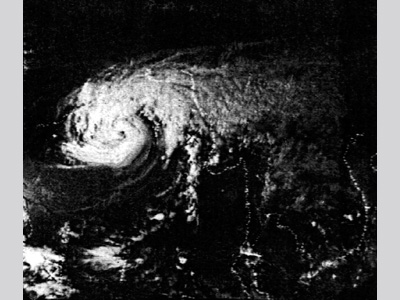Bangladesh (formerly East Pakistan) is a densely-populated delta country that sits on sediments eroded from the Himalayan Mountains. Thirty-five percent of the area is less than 6 m (20 ft) above sea level, and over 20% of the entire country is submerged beneath annual river floods in an average year. The 575 km (360 mi)-long coastline is contoured in such a way that it funnels cyclones from the warm waters of the Bay of Bengal into the area. About five tropical cyclones per year enter the Bay of Bengal both before (April-May) and after (October-November) the southwest monsoon season.
Remnants of a tropical storm in the Pacific contributed to the development of a new depression in the central Bay of Bengal on November 8, 1970. Although there were not direct measurements of the winds of pressure in the storm, satellite imagery suggests that the storm intensified rapidly, becoming a well-defined cyclone with sustained winds between 137-145 km/h (85-90 mph) by 11 November. The system traveled north and intensified, driving into the low-lying delta area overnight on 12 November, during an above-average lunar high tide. With it, the cyclone brought a 6 m (20 ft)-storm surge and average winds in excess of 225.3 km/h (140 mph). Although meteorologists knew of the approaching storm, there was no way to communicate to most of those living in the coastal plain and on the islands of the Ganges River delta. As a result, approximately 300,000-500,000 people were killed (many had been asleep when the storm surge struck), making this storm the deadliest tropical cyclone of all time and one of the deadliest natural disasters in recent history. The Pakistani government was severely criticized for its handling of relief operations following the disaster. The opposition Awami League gained a landslide victory during general elections held that December in the province, partially a result of the national government’s failed relief efforts. Although there was political discord in place prior to the cyclone’s strike, the landslide victory and continuing unrest between East Pakistan and the central government triggered the Bangladesh Liberation War, which widened into the Indo-Pakistani War of 1971. The war concluded with the creation of the state of Bangladesh in December 1971. Fast Facts:
Sources:
"Bangledesh". In: Library of Natural Disasters- Hurricanes, Typhoons, and Other Tropical Cyclones. 2008. Editor in Chief, Paul A. Kobasa. World Book. Chicago Pp 38-39 Longshore, David. 1998. Great Cyclone of 1970. In: Encyclopedia of hurricanes, typhoons, and cyclones. Facts on File, Inc. New York. Pp. 147-149. Emanuel, Kerry. 2005. The Great East Pakistan Cyclone of November 1970. In: Divine Wind. Pp. 221-225. Wikipedia- 1970 Bhola Cyclone http://en.wikipedia.org/wiki/1970_Bhola_cyclone |


